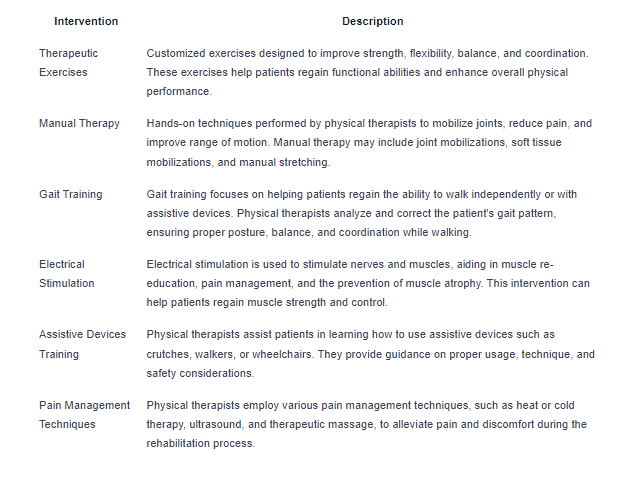Inpatient Rehab Physical Therapy
March 5, 2025
Unlock your recovery potential with inpatient rehab physical therapy. Discover the benefits and support for a successful journey.



Understanding Inpatient Rehab Physical Therapy
Inpatient rehab physical therapy plays a vital role in helping individuals recover and regain their functional abilities after a significant injury, illness, or surgery. This section will provide an overview of what inpatient rehab physical therapy entails and the goals associated with this type of therapy.
What is Inpatient Rehab Physical Therapy?
Inpatient rehab physical therapy refers to the specialized rehabilitation services provided to patients who are admitted to a hospital or rehabilitation facility for intensive therapy. This type of therapy is typically recommended for individuals who require a higher level of care and supervision due to the complexity of their condition or the extent of their functional limitations.
During inpatient rehab physical therapy, individuals work closely with a team of healthcare professionals, including physical therapists, to develop a personalized treatment plan. The therapy sessions are conducted within the hospital or rehab facility, where patients have access to 24-hour medical care and support.
Goals of Inpatient Rehab Physical Therapy
The primary goals of inpatient rehab physical therapy are to improve functional independence, enhance mobility, and facilitate a safe transition back to the community. The therapy program is tailored to meet the specific needs and abilities of each individual, focusing on addressing their unique challenges and limitations.
Some common goals of inpatient rehab physical therapy include:
- Restoring mobility and strength: Physical therapists use various exercises and techniques to help patients regain strength, flexibility, and balance. This may involve strengthening exercises, range of motion exercises, and functional training to improve mobility and overall physical function.
- Managing pain and discomfort: Inpatient rehab physical therapy may include pain management strategies, such as therapeutic modalities (e.g., heat or cold therapy, electrical stimulation) and manual therapy techniques (e.g., massage, joint mobilizations), to alleviate pain and promote healing.
- Enhancing independence in daily activities: Physical therapists focus on helping patients improve their ability to perform activities of daily living, such as walking, dressing, and bathing, to increase their independence and quality of life.
- Preparing for a safe transition home: Inpatient rehab physical therapy also aims to prepare patients for a successful transition from the hospital or rehab facility back to their home environment. This may involve teaching adaptive strategies, recommending assistive devices, and providing education on self-care techniques to ensure a smooth transition and ongoing progress.
By understanding the purpose and objectives of inpatient rehab physical therapy, individuals can approach their rehabilitation journey with clarity and confidence. The collaborative efforts of the healthcare team, along with the commitment of the patients, help pave the way for improved mobility, function, and overall recovery.
The Inpatient Rehab Setting
Inpatient rehabilitation facilities play a critical role in providing comprehensive care and support to individuals in need of physical therapy. These facilities offer a structured and supervised environment where patients can receive intensive rehabilitation services. Let's explore the overview of inpatient rehabilitation facilities and the multidisciplinary approach to care they employ.
Overview of Inpatient Rehabilitation Facilities
Inpatient rehabilitation facilities are specialized healthcare centers that focus on providing intensive rehabilitation services to individuals recovering from injuries, surgeries, or medical conditions. These facilities are equipped with dedicated rehabilitation units and a team of healthcare professionals who specialize in various aspects of rehabilitation.
The primary goal of inpatient rehabilitation facilities is to improve the functional abilities and independence of patients through a comprehensive and individualized treatment plan. Patients typically stay at these facilities for a specific period, ranging from a few days to several weeks, depending on their needs and progress.
Inpatient rehabilitation facilities offer a wide range of services, including physical therapy, occupational therapy, speech therapy, nursing care, and psychological support. The collaborative efforts of these healthcare professionals enable patients to receive holistic care and maximize their recovery potential.
Multidisciplinary Approach to Care
One of the key features of inpatient rehabilitation facilities is their multidisciplinary approach to care. This approach involves a team of healthcare professionals working together to develop and implement a personalized treatment plan for each patient. The team typically includes:
- Physicians: Medical doctors who oversee the patient's overall care, manage medications, and monitor progress.
- Physical Therapists: Experts in restoring and improving physical function, mobility, and strength through targeted exercises and therapeutic techniques.
- Occupational Therapists: Professionals who assist patients in regaining independence in daily activities, such as dressing, bathing, and cooking.
- Speech Therapists: Specialists who help patients with speech, language, swallowing, and cognitive difficulties.
- Nurses: Skilled healthcare professionals who provide 24/7 monitoring, administer medications, and assist with daily care needs.
- Psychologists/Counselors: Mental health professionals who provide emotional support, coping strategies, and counseling services.
- Social Workers: Professionals who assist patients and their families in navigating the healthcare system, accessing community resources, and planning for discharge.
The collaboration and coordination among these professionals ensure that patients receive comprehensive care across different aspects of their recovery journey. By addressing physical, emotional, and functional needs, the multidisciplinary approach enhances the overall effectiveness of inpatient rehab physical therapy.
Inpatient rehabilitation facilities offer a supportive and structured environment where patients can focus on their recovery and receive comprehensive care from a dedicated team of healthcare professionals. This combination of specialized services and multidisciplinary care sets the stage for a successful rehabilitation journey.

The Role of Physical Therapy
Physical therapy plays a crucial role in the inpatient rehab setting, aiding patients in their journey towards recovery and regaining optimal physical function. Let's explore the importance of physical therapy in inpatient rehab and the various types of physical therapy interventions commonly utilized.
Importance of Physical Therapy in Inpatient Rehab
Inpatient rehab physical therapy is vital for assisting patients in regaining strength, mobility, and independence after a significant injury, surgery, or illness. The primary goal of physical therapy in this setting is to optimize functional outcomes and enhance overall quality of life.
Physical therapists are trained professionals who work closely with patients to create personalized treatment plans tailored to their specific needs. They utilize a variety of techniques and interventions to address impairments, reduce pain, and restore physical function. By providing hands-on care, education, and guidance, physical therapists empower patients on their road to recovery.
Types of Physical Therapy Interventions
Physical therapy interventions in the inpatient rehab setting are diverse and specialized, aiming to address the unique needs and conditions of each patient. Here are some common types of physical therapy interventions utilized:

Each patient's treatment plan may consist of a combination of these interventions or others that are tailored to their specific needs and goals. The physical therapist closely monitors the patient's progress, adjusts the treatment plan as necessary, and collaborates with other members of the healthcare team to provide comprehensive care.
Understanding the importance of physical therapy in the inpatient rehab setting and the variety of interventions available highlights the significant role that physical therapists play in promoting recovery, optimizing physical function, and enhancing the overall well-being of patients.
Progression and Recovery
In the journey of inpatient rehab physical therapy, monitoring progress and transitioning to outpatient care are crucial steps in the overall recovery process.
Monitoring Progress in Physical Therapy
During inpatient rehab physical therapy, regular monitoring of progress is essential to ensure that the treatment plan is effective and tailored to the individual's needs. Physical therapists utilize various methods to track progress and adjust the therapy accordingly. These may include:
- Functional Assessments: These assessments evaluate the patient's ability to perform daily activities and measure improvements in mobility, strength, and balance. They provide valuable insights into the patient's progress and help set realistic goals for recovery.
- Range of Motion Measurements: Physical therapists assess the range of motion in affected joints or muscles. These measurements are recorded and compared over time to track improvements or identify areas that require additional focus.
- Strength and Endurance Testing: Objective strength and endurance tests are conducted to assess muscular strength and stamina. These tests provide measurable data to gauge progress and guide the therapist in designing appropriate exercises and interventions.
- Pain Assessment: Pain levels and changes are monitored to evaluate the effectiveness of pain management strategies and interventions. This helps ensure that the patient's pain is adequately addressed, allowing for an optimal rehabilitation experience.
By regularly monitoring progress, physical therapists can make informed decisions regarding modifications to the treatment plan, exercise intensity, and goals. Open communication between the patient and therapist is key to accurately tracking progress and making necessary adjustments along the way.
Transitioning to Outpatient Care
As patients make significant progress in their inpatient rehab physical therapy, the next step in their recovery journey is transitioning to outpatient care. Outpatient physical therapy allows individuals to continue their rehabilitation in a less intensive setting while still receiving necessary support and guidance.
During the transition, the physical therapist collaborates with the patient to develop an individualized outpatient care plan. This plan focuses on maintaining and advancing the progress made during inpatient rehab. The outpatient care plan may include:
- Continued Rehabilitation Exercises: Patients are provided with a set of exercises to perform at home or in a clinic under the guidance of a physical therapist. These exercises are designed to build upon the gains achieved during inpatient rehab and further improve strength, flexibility, and function.
- Education and Self-Management Strategies: Patients are taught techniques to manage their condition independently and prevent further injury. This may include strategies for pain management, proper body mechanics, and lifestyle modifications to support their ongoing recovery.
- Follow-up Appointments: Regular follow-up appointments are scheduled to assess progress, address any concerns or challenges, and make any necessary adjustments to the outpatient care plan. These appointments allow the physical therapist to provide ongoing support, monitor the patient's continued progress, and offer guidance as needed.
Transitioning to outpatient care empowers patients to take an active role in their recovery while receiving the necessary guidance and support from their physical therapist. It allows for a gradual shift from a supervised setting to more independent management of their rehabilitation journey.
Benefits of Inpatient Rehab Physical Therapy
Inpatient rehab physical therapy offers several benefits to individuals who require intensive rehabilitation and support. Let's explore two key advantages: improved mobility and function, and effective pain management and rehabilitation.
Improved Mobility and Function
One of the primary goals of inpatient rehab physical therapy is to improve an individual's mobility and function. Through targeted exercises, techniques, and interventions, physical therapists work closely with patients to address their specific needs and challenges. By focusing on strengthening muscles, increasing flexibility, and improving balance, physical therapy can help patients regain their ability to perform daily activities and regain independence.
Physical therapists utilize various techniques to enhance mobility and function, such as:
- Range of motion exercises: These exercises aim to improve flexibility and joint mobility, allowing individuals to move more freely.
- Strength training: By targeting specific muscle groups, strength training exercises help individuals rebuild muscle strength and regain functional abilities.
- Balance and coordination exercises: These exercises focus on improving balance and coordination, reducing the risk of falls and enhancing overall stability.
- Gait training: Gait training involves relearning how to walk properly, helping individuals regain a natural and efficient walking pattern.
Through a personalized and structured physical therapy program, inpatient rehab can significantly contribute to improved mobility and function, enabling individuals to regain their independence and quality of life.
Pain Management and Rehabilitation
Inpatient rehab physical therapy also plays a crucial role in pain management and rehabilitation. Following an injury, surgery, or illness, pain can be a significant barrier to recovery. Physical therapists are trained to assess and address pain through various therapeutic techniques.
Physical therapy interventions for pain management and rehabilitation may include:
- Manual therapy: This hands-on approach involves skilled manipulation and mobilization of muscles, joints, and soft tissues to reduce pain and improve mobility.
- Modalities: Physical therapists may use modalities such as heat, cold, ultrasound, or electrical stimulation to alleviate pain and promote healing.
- Therapeutic exercises: Specific exercises designed to target and alleviate pain are incorporated into the treatment plan, promoting strength, flexibility, and improved function.
- Education and self-management strategies: Physical therapists educate patients about pain management techniques, body mechanics, and self-care strategies to empower them in their recovery process.
By addressing pain and providing effective rehabilitation, inpatient rehab physical therapy helps individuals manage discomfort, enhance healing, and promote a smoother recovery journey.
Inpatient rehab physical therapy offers numerous benefits beyond improved mobility and pain management. It provides a comprehensive and individualized approach to address the unique needs of each patient, ultimately facilitating a successful recovery and a return to an active and fulfilling life.

Patient Education and Support
Inpatient rehab physical therapy not only focuses on the physical aspect of recovery but also emphasizes patient education and support. Empowering patients with knowledge and providing resources for continued recovery are essential components of the rehabilitation process.
Empowering Patients for Long-Term Health
Patient education plays a vital role in inpatient rehab physical therapy. By providing patients with information about their condition, treatment options, and self-care techniques, they are empowered to take an active role in their recovery journey. Education helps patients understand the importance of therapy exercises, proper body mechanics, and the potential risks and benefits of different interventions.
By actively involving patients in their treatment plan, they gain a sense of ownership and responsibility for their health. This empowerment can lead to improved compliance with therapy exercises and lifestyle modifications, ultimately contributing to better long-term outcomes.
Resources for Continued Recovery
In addition to patient education, inpatient rehab physical therapy also provides patients with resources and support for continued recovery beyond their inpatient stay. These resources can include:
- Home Exercise Programs: Physical therapists often design customized home exercise programs tailored to the specific needs and capabilities of each patient. These programs enable patients to continue their rehabilitation exercises independently, promoting ongoing progress and maintenance of functional gains.
- Community-based Support Groups: Support groups provide a platform for individuals with similar conditions or experiences to come together, share their challenges and successes, and provide emotional support. These groups can be instrumental in promoting motivation, accountability, and a sense of belonging.
- Referrals to Outpatient Services: As patients transition from the inpatient setting back to their regular lives, they may require ongoing outpatient physical therapy services. Physical therapists can provide referrals to appropriate outpatient programs or clinics, ensuring continuity of care and continued progress.
- Educational Materials: Printed or digital resources, such as brochures, pamphlets, or online articles, can serve as valuable references for patients. These materials may cover topics such as proper body mechanics, injury prevention strategies, and self-care techniques. Accessible and understandable educational resources empower patients to make informed decisions about their health and well-being.
By offering patient education and ongoing support, inpatient rehab physical therapy aims to equip individuals with the knowledge, resources, and tools necessary for long-term health and successful recovery. When patients feel supported and informed, they are better prepared to navigate their rehabilitation journey and maintain their functional gains even after completing their inpatient rehabilitation program.
Sources
https://www.hcafloridahealthcare.com/specialties/inpatient-physical-rehabilitation
https://www.rehabselect.net/facts-about-inpatient-rehab-versus-outpatient-therapy
https://encompasshealth.com/inpatient-rehabilitation













